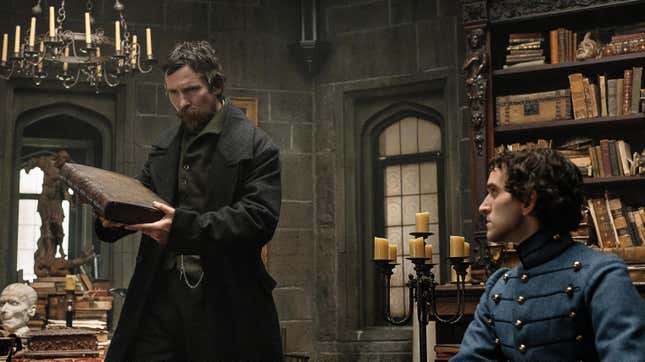
At first glance, The Pale Blue Eye has everything audiences could want in a chilling, wintry thriller: a well-stocked cavalcade of actors, eerie aesthetics, and an intriguing premise centered on a depressed detective and a young macabre poet-to-be recruited to solve gruesome murders at a military academy. However, the unrelentingly bleak material, adapted by writer-director Scott Cooper from author Louis Bayard’s novel, fails to provide more than a straightforward whodunit with a tacked-on reveal relying on frustrating contrivances. We don’t see its biggest twist coming—and, as it turns out, that’s the problem.
In the winter of 1830, renowned police detective August Landor (Christian Bale) is called out of retirement by West Point Military Academy’s finest, Captain Hitchcock (Simon McBurney) and Superintendent Colonel Sylvanus Thayer (Timothy Spall). They’ve discovered the body of a young cadet hanging in the neighboring woods and, because of its positioning, aren’t sure if it’s suicide or the start of something more sinister. A short stint on Dr. Daniel Marquis’ (Toby Jones) examination table shows that the corpse has been tampered with, crudely cut open and robbed of its heart. To save the honor of the Academy, Landor is implored to investigate—and, with nothing to lose since his wife is dead and his daughter has disappeared, he agrees.
Landor enlists the help of eccentric cadet Edgar Allan Poe (Harry Melling), who sounds like a Southern carnival barker and has a quick wit and an ability to move discreetly amongst the elite enrollment. As killings continue with the deaths of livestock, Landor pieces together clues that point to the occult—a theory shared by his pal, expert Jean-Pepe (Robert Duvall). Poe’s footwork as a mole begins to yield payoffs as well, not only narrowing down his list of possible perpetrators, but also introducing him to elusive lady love Lea Marquis (Lucy Boynton). But when another cadet turns up similarly murdered and mutilated, the pair’s mission becomes pressing and personal.
This is a case of one movie with two endings, and neither of them totally satisfy. The Pale Blue Eye’s molasses-slow energy builds to an expected grand dénouement dealing with certain mischievous bedfellows, but it places its weight on the wrong climax, finishing on a painfully restrained note that causes us to question its illogical choices. And Cooper frequently experiences trouble foreshadowing his final “Gotcha!” moment. Instead of being cleverly disguised, it’s buried deep and comes out of nowhere, rendering the secondary mystery rote and both endings riddled with convenience. From the note excerpt clutched in the dead cadet’s hand to the diary handed over by his mother, clues fall into the heroes’ laps rather than being found through detective skills—and we only glimpse a little of that procedural aspect.
Landor and Poe’s relationship dynamic begins on a strong note, bantering and bonding, but fails to carry through to an earned, heartrending conclusion as the filmmakers clearly intended. This pairing’s spin on the reliable detective movie trope—where a jaded old cop is paired with a wide-eyed rookie—takes on deeper meaning when, through the course of the case, Landor starts thinking of Poe as a surrogate son. But we rarely see this properly developed and it directly impacts the emotional payoff, which lacks the gut-punch needed to land its headier goals and innovative character-driven designs.

Though nothing compared to their superior collaborations Out Of The Furnace and Hostiles, Cooper gives Bale shining moments to dig deep into the pathos of his distraught, disillusioned character, subtly spotlighting the story’s overarching themes of devotion and servitude that, when taken to the extreme, can corrupt one’s soul. The satin ribbon he occasionally strokes symbolizes a brilliant touchstone to his own humanity. He shares a strong chemistry with Melling, whose compelling presence is sorely missed when he’s not on screen. Lea, Patsy the gossipy barmaid (Charlotte Gainsbourg), Dr. Marquis’ weird wife Julia (Gillian Anderson), and missing daughter Mattie (Hadley Robinson) all serve to exclusively aid male arcs. The actresses elevate these roles in their delicately nuanced performances; however, the material is one-dimensional at best.
While the narrative awkwardly fumbles, its brilliantly faceted aesthetic craftsmanship soars. Cooper uses natural landscapes—everything from foggy forests and jagged, rocky river shores—to enhance tonal unease. Masanobu Takayanagi’s cinematography, with its cold, bruising blue and black palette almost bled of color to evoke early-age photographs, delivers a tangible sense of moody atmosphere. Kasia Walicka-Maimone’s costume designs turn an astute eye toward hidden character traits, especially when it comes to Lea and her mother Julia, whose massively puffy sleeves and voluminous gowns are stuffed with family secrets. Detailed soundscapes are crucial for giving the Marquis manor its creepy, foreboding manner and West Point a feeling of hollowness with wind gusts howling through these cavernous settings. Plus, Howard Shore’s austere score infuses dread into the proceedings.
Although Cooper’s Poe-centric picture integrates the famous figure in a less gimmicky grab at Gothic-inspired thrills than its kissing cousin The Raven, it winds up similarly hobbling itself at the hands of its hamstrung narrative. Clearly, craft and care were woven into the film’s fabric. It’s just that when we start pulling at its loose ends, it quickly unravels.